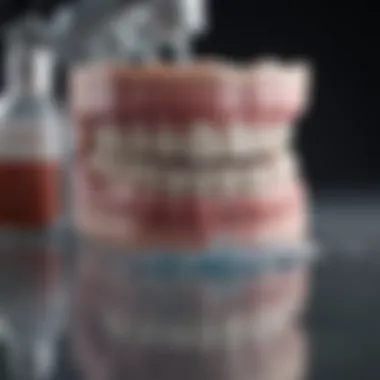Hydrogen Peroxide: A Powerful Ally for Dental Health


Intro
Hydrogen peroxide is more than just a common household item; it serves a multifaceted purpose in the realm of dental healthcare. This article reveals the significance of hydrogen peroxide in maintaining oral hygiene and its potential in enhancing dental aesthetics. With increased interest in natural and effective dental solutions, hydrogen peroxide emerges as a key player. Its unique properties allow it to be utilized in various applications, from teeth whitening to disinfection at the microbial level. However, understanding the implications of its use is essential for safe application.
Key Concepts
Definition of the Main Idea
Hydrogen peroxide is a chemical compound with the formula H₂O₂. It acts as a strong oxidizing agent, making it valuable in several applications, particularly in dentistry. Its capability to decompose into water and oxygen makes it a gentle yet effective agent for oral health. In dental care, it primarily functions in whitening teeth, controlling plaque, and serving as an antibacterial rinse.
Overview of Scientific Principles
Understanding the science behind hydrogen peroxide is essential for appreciating its applications. The oxygen released during its breakdown can penetrate biofilms and reach bacteria, facilitating effective cleaning. Additionally, it creates an environment that's less conducive to bacterial growth, supporting overall oral health. Through oxidation, hydrogen peroxide can alter the chromophore structures in teeth, resulting in a whiter appearance. The concentration levels, method of application, and contact time play crucial roles in determining its effectiveness and safety.
Current Research Trends
Recent Studies and Findings
Current research increasingly emphasizes the benefits and potential risks of hydrogen peroxide use in dentistry. Studies suggest that at low concentrations, it is effective for teeth whitening while minimizing sensitivity. Recent findings indicate that using hydrogen peroxide regularly as a mouth rinse can reduce gingivitis and improve oral microbiota balance.
Significant Breakthroughs in the Field
Breakthroughs in fluoride or carbamide peroxide formulations combined with hydrogen peroxide have shown promising results in enhancing whitening efficiency and user experience. Innovations in delivery methods, like toothpaste containing hydrogen peroxide, present new opportunities for daily oral care.
"Hydrogen peroxide not only whitens teeth but also plays a role in reducing harmful bacteria in the mouth, creating a healthier oral environment."
"Hydrogen peroxide not only whitens teeth but also plays a role in reducing harmful bacteria in the mouth, creating a healthier oral environment."
Foreword to Hydrogen Peroxide
Hydrogen peroxide, a simple yet effective compound, has gained substantial attention in the field of dentistry. Its multifaceted applications range from teeth whitening to oral hygiene management, making it essential for both professionals and everyday users. Understanding hydrogen peroxide is crucial, as it helps individuals make informed decisions regarding oral health practices. The role of hydrogen peroxide in dental care transcends basic cleaning; it addresses common concerns like gum disease, bad breath, and even oral sores. Therefore, evaluating its effectiveness and safety becomes imperative.
Chemical Properties
Hydrogen peroxide is a chemical compound with the formula H₂O₂. It appears as a clear liquid with a slightly bitter taste. The molecular structure features a pair of oxygen atoms, which are bonded to two hydrogen atoms. Its properties make hydrogen peroxide a powerful oxidizing agent. This means it can react with various substances, leading to a range of chemical reactions. In the context of oral health, this reactivity is advantageous for its ability to break down stains and disinfect surfaces. Moreover, hydrogen peroxide is effective in releasing free radicals that can help eliminate bacteria in the mouth, contributing to better oral hygiene.
Concentration Variations
Concentration is a critical aspect of hydrogen peroxide's application in dentistry. It is available in various concentrations, commonly ranging from 3% to 35% for general use. The 3% solution is commonly found in household products and is safe for teeth whitening and oral rinsing. Conversely, higher concentrations, such as 10% to 35%, are typically used in professional treatments under strict supervision.
Using the appropriate concentration is vital to achieve desired outcomes without causing harm. For instance, lower concentrations may be less effective for deep stains but are safer for regular use, reducing the risk of gum irritation or enamel damage. It is essential to respect the guidelines for dilution and application in order to harness hydrogen peroxide's benefits effectively while minimizing potential adverse effects.
Hydrogen Peroxide as a Whitening Agent
Hydrogen peroxide serves a significant role in cosmetic dentistry, particularly as a whitening agent for teeth. Many individuals seek brighter smiles, and this compound is often at the forefront of their options. Its effectiveness at breaking down stains not only helps improve the aesthetic appeal of teeth but also boosts confidence in one's appearance. As we explore this topic, it becomes clear that understanding hydrogen peroxide's role in whitening sheds light on its broader applications in oral healthcare.
Mechanism of Action
Hydrogen peroxide whitens teeth through a chemical process known as oxidation. When applied to the surface of the enamel, hydrogen peroxide breaks down into water and oxygen free radicals. These free radicals penetrate the tooth structure and react with the darker pigments that cause discoloration, effectively breaking them apart. This reaction leads to a lighter and brighter shade of enamel.


The concentration of hydrogen peroxide used can greatly influence its effectiveness. Higher concentrations yield quicker results, but they can also increase the risk of adverse reactions such as sensitivity or irritation. Therefore, it is essential to determine the right concentration for individual needs.
Effectiveness Compared to Other Methods
Hydrogen peroxide is frequently compared to other whitening methods such as whitening strips, gels, and professional treatments performed in a dentist's office. Among these options, hydrogen peroxide often stands out due to its potency.
- Professional Treatments: These typically utilize higher concentrations of hydrogen peroxide, leading to more dramatic results in less time. However, they often come at a higher cost and may require multiple appointments.
- Whitening Strips and Gels: While convenient, over-the-counter strips usually contain lower concentrations of hydrogen peroxide, which means results may take longer to achieve compared to stronger formulations.
In many cases, individuals find that hydrogen peroxide-based products effectively offer good results with proper application techniques.
Potential Side Effects
While hydrogen peroxide is widely regarded as effective, it is crucial to consider the potential side effects. Some common side effects include:
- Tooth Sensitivity: Increased sensitivity can occur after application, especially with higher concentrations. Individuals may experience discomfort when consuming hot or cold substances.
- Gum Irritation: Direct contact with gums can lead to irritation or burning sensations. It is important to apply the product carefully around the gum line.
- Enamel Damage: Overuse or using concentrated solutions improperly may result in damage to enamel, leading to more significant dental issues in the long run.
Always consult with a dental professional before beginning any whitening regimen that involves hydrogen peroxide to ensure both safety and effectiveness.
Always consult with a dental professional before beginning any whitening regimen that involves hydrogen peroxide to ensure both safety and effectiveness.
Managing Oral Hygiene with Hydrogen Peroxide
Maintaining oral hygiene is crucial for overall health. Poor hygiene can lead to various dental issues, including cavities, periodontitis, and bad breath. Hydrogen peroxide presents a unique solution to enhance oral care routines. Its chemical composition allows it to act effectively against harmful bacteria that contribute to oral diseases. Using hydrogen peroxide can help in achieving cleaner teeth and healthier gums.
Germicidal Properties
Hydrogen peroxide is well-known for its germicidal properties. It generates reactive oxygen species that can kill bacteria, viruses, and fungi. When applied to the mouth, hydrogen peroxide creates an environment less favorable for pathogens. This makes it a powerful ally in fighting harmful microorganisms. The effectiveness of hydrogen peroxide in killing bacteria can be particularly useful for individuals with compromised immune systems or those prone to infections.
Rinsing Solutions
Using hydrogen peroxide as a mouth rinse is a common practice in many households. To create a simple yet effective mouth rinse, dilute hydrogen peroxide with water. A common ratio is one part hydrogen peroxide to two parts water. This dilution helps prevent irritation while still maintaining its antimicrobial properties. Swishing this solution can help in cutting down plaque and reducing gum inflammation. After rinsing, it is advisable to follow up with plain water to eliminate any residual hydrogen peroxide from the mouth.
Comparison to Traditional Mouthwashes
When comparing hydrogen peroxide solutions to traditional mouthwashes, several factors come into play. Many commercial mouthwashes contain alcohol and artificial flavors, while hydrogen peroxide offers a natural alternative. Additionally, traditional mouthwashes may not have the same level of efficacy against oral bacteria as hydrogen peroxide does. This consideration makes hydrogen peroxide a compelling option for those who prefer a simple, straightforward approach to oral hygiene. However, it is essential to note that hydrogen peroxide should not entirely replace regular dental care, such as brushing and flossing.
The versatility of hydrogen peroxide extends beyond just teeth whitening; its properties enable users to improve their overall oral hygiene effectively.
The versatility of hydrogen peroxide extends beyond just teeth whitening; its properties enable users to improve their overall oral hygiene effectively.
Treating Oral Conditions with Hydrogen Peroxide
Hydrogen peroxide serves not only as a whitening agent but also offers significant benefits in treating various oral conditions. Its strong oxidizing properties provide antibacterial and anti-inflammatory effects, making it a valuable tool in oral health management. Understanding the specific applications of hydrogen peroxide in treating mouth sores, gingivitis, and other dental issues is essential for anyone looking to enhance their oral hygiene routine while addressing specific concerns.
Mouth Sores and Ulcers
Mouth sores, including canker sores, are painful and can hinder daily activities such as eating and speaking. Hydrogen peroxide can aid in their treatment. When diluted properly, it acts as a disinfectant, promoting healing by reducing bacterial load in the affected area.
- Usage: A common method involves creating a rinse using equal parts hydrogen peroxide and water. Patients can swish this solution in their mouths for about 30 seconds and then spit it out. This can be done multiple times a day until relief is found.
It is important to note that overuse can lead to irritation of the mucous membranes, so moderation is key.


Gingivitis and Periodontitis
Gingivitis, an inflammation of the gums, and periodontitis, a more severe form of gum disease, are conditions that can significantly impact oral health. Hydrogen peroxide's dual action makes it suitable for tackling these issues.
- Mechanism: The effervescence produced by hydrogen peroxide helps to eliminate debris and bacteria from gum pockets. This is crucial in combating the root causes of gingivitis and periodontitis.
- Application: Regular use as a mouth rinse may reduce plaque buildup when incorporating it alongside proper brushing and flossing techniques. For those suffering from gum disease, a solution typically consists of a lower concentration of hydrogen peroxide mixed with water.
Other Applications
Beyond the common uses previously mentioned, hydrogen peroxide can further extend its benefits to other oral health concerns. It can be employed in the treatment of:
- Fungal Infections: Hydrogen peroxide can help to clear oral thrush, a fungal infection characterized by white patches in the mouth.
- Tooth Discoloration: While primarily known for whitening, it also aids in removing surface stains from teeth, which can be a result of certain food items or behaviors.
- Overall Oral Hygiene: Incorporating hydrogen peroxide into regular dental care may contribute positively to maintaining general oral health.
Hydrogen peroxide enhances the effectiveness of regular brushing and flossing through its antibacterial action.
Hydrogen peroxide enhances the effectiveness of regular brushing and flossing through its antibacterial action.
In summary, hydrogen peroxide must be used with thoughtful consideration regarding concentration and moderation. By recognizing its versatile applications in treating oral conditions, individuals can better manage their dental health effectively.
Safety Considerations
Safety considerations are crucial when using hydrogen peroxide for dental care. Understanding how to handle this compound properly ensures effectiveness while minimizing potential risks. This section delves into proper dilution techniques, contraindications, and the storage and shelf life of hydrogen peroxide, providing essential guidance for safe usage.
Proper Dilution Techniques
Diluting hydrogen peroxide before use is important to avoid damage to oral tissues. When using concentrations above 3%, the risk of irritation and chemical burns increases. The typical recommendation for oral applications is a solution ranging from 1% to 3% concentration. To achieve this, mix equal parts of hydrogen peroxide with water. For instance, if you have 3% hydrogen peroxide, mix one part the peroxide with two parts water for a safer rinse. Using a correctly diluted solution helps in harnessing the compound's benefits while protecting the mouth and gums.
Contraindications
Despite its advantages, hydrogen peroxide is not suitable for everyone. Individuals with certain health issues should exercise caution or avoid its use. Pregnant or breastfeeding women should consult a healthcare provider before using hydrogen peroxide, as the effects on fetal or infant development are not well-studied. Furthermore, people with a history of oral ulcers or severe sensitivity might experience exacerbated discomfort. It is prudent to seek advice from a dentist or medical professional to evaluate individual risks and benefits before incorporating hydrogen peroxide into oral hygiene routines.
Storage and Shelf Life
The storage of hydrogen peroxide is vital for maintaining its stability and effectiveness. Store hydrogen peroxide in a cool, dark place. Exposure to light can break down the compound, diminishing its efficacy. Typically, hydrogen peroxide has a shelf life of about one to three years when stored properly. Check for discoloration or a change in consistency; if either occurs, it is wise to dispose of the solution. Original containers often feature opaque materials designed to limit light exposure, which further contributes to its longevity. Safe storage practices will prolong the usability of hydrogen peroxide, ensuring its effectiveness when needed.
Always prioritize safety when incorporating hydrogen peroxide into any dental care regimen. Proper dilution, awareness of contraindications, and correct storage practices can make a significant difference in ensuring both effectiveness and safety.
Always prioritize safety when incorporating hydrogen peroxide into any dental care regimen. Proper dilution, awareness of contraindications, and correct storage practices can make a significant difference in ensuring both effectiveness and safety.
Alternatives to Hydrogen Peroxide
Exploring alternatives to hydrogen peroxide is a vital aspect of understanding oral care. While hydrogen peroxide has proven benefits, there are situations where other options may be more appropriate or preferred. These alternatives can vary in effectiveness, safety, and application methods, depending on individual needs and preferences.
Natural Remedies
Natural remedies present a diverse array of options for oral care. Many people seek these alternatives due to personal beliefs or sensitivity to chemical compounds. Some popular natural remedies include:
- Baking Soda: Acts as a mild abrasive and whitens teeth while neutralizing acids in the mouth.
- Coconut Oil: Commonly used for oil pulling, it helps to reduce plaque and maintain fresh breath.
- Apple Cider Vinegar: Though acidic, it may assist in removing stains but should be used with caution due to its potential to erode enamel.
- Activated Charcoal: Claimed to absorb plaque and stains, it has gained popularity but should be used sparingly to avoid wear on enamel.
While these remedies can be effective, their applications should be understood clearly. Consulting with a dental professional is encouraged to ensure safe usage.


Professional Treatments
For those seeking robust solutions, professional treatments offer significant benefits. Dentists and dental hygienists provide options that deliver effective results with controlled application. Here are some common professional treatments:
- In-Office Whitening: This method uses stronger bleaching agents to quickly achieve noticeable results. It generally provides faster outcomes than at-home treatments.
- Professional Cleanings: Regular cleanings can prevent stain buildup and maintain oral health more effectively than DIY methods.
- Custom Trays for Home Use: Dentists can create custom trays that fit the patient's mouth, allowing them to safely use professional whitening agents at home.
- Veneers: Though not a whitening method, veneers can cover discolored teeth, providing an immediate aesthetic improvement.
Professional treatments tend to yield consistent results since they are supervised-by trained specialists.
Professional treatments tend to yield consistent results since they are supervised-by trained specialists.
Considering these alternatives allows individuals to make informed decisions. Each option has unique characteristics suited to different circumstances, ensuring patients can find the best fit for their oral health journey.
Regulatory Perspectives
Understanding the regulatory landscape surrounding hydrogen peroxide is essential for anyone considering its use in dental care. This section dissects the frameworks that govern the formulation, sale, and recommendation of hydrogen peroxide in dental applications. Regulatory guidelines ensure that the products made available to consumers are both safe and effective. As such, compliance with these standards not only protects public health but also builds trust in the products that dental professionals employ.
FDA Guidelines
The U.S. Food and Drug Administration (FDA) plays a critical role in regulating the use of hydrogen peroxide in multiple applications, including dental. The FDA categorizes hydrogen peroxide intended for consumer use as a safe and approved product, primarily when used at specified concentrations. Here are key points concerning FDA regulations:
- Approved Concentrations: The FDA has established safe concentration levels for dental products, particularly in whitening solutions. Products that contain hydrogen peroxide typically range from 3% to around 10% for over-the-counter options, while professional treatments can have higher concentrations, such as 20% to 40%.
- Labeling Requirements: The FDA mandates clear labeling of hydrogen peroxide products, ensuring consumers understand the uses, precautions, and potential side effects associated with the compound.
- Clinical Evidence: Products claiming to provide whitening or therapeutic effects must be backed by clinical evidence demonstrating their efficacy and safety, which is crucial to maintain FDA approval.
Overall, the FDA's guidelines are crafted to safeguard users while promoting informed choices about hydrogen peroxide products in oral care. Understanding these guidelines can help consumers navigate available options effectively.
Dentist Recommendations
Dentists often provide the most reliable information on the use of hydrogen peroxide in oral health practices. Their recommendations are generally grounded in clinical experience and a thorough understanding of the patient's unique dental situation. Here are some common points that dentists emphasize when discussing the use of hydrogen peroxide:
- Professional Use vs. Home Use: Dentists usually recommend professional treatments for higher concentrations, as they ensure that the procedure is conducted safely. Overuse of high concentrations at home can lead to adverse effects.
- Personalized Care: Each patient's dental health is different. A dentist evaluates individual needs before suggesting hydrogen peroxide, focusing on specific concerns like whitening needs or oral hygiene management.
- Monitoring Effects: Dentists advocate for regular check-ups to monitor the effects of hydrogen peroxide use, particularly for patients using it for whitening or managing conditions like gingivitis.
- Education and Training: Dentists promote education on the proper use of hydrogen peroxide, stressing that patients need to follow guidelines for dilution and application to avoid complications.
"Understanding how to use hydrogen peroxide effectively and safely requires insights from dental professionals who can provide personalized recommendations."
"Understanding how to use hydrogen peroxide effectively and safely requires insights from dental professionals who can provide personalized recommendations."
Ending
Hydrogen peroxide is an influential and multifaceted substance that has significant applications in dental care. Its use can yield several benefits, from teeth whitening to managing oral health. However, it is essential to recognize the precautions necessary for safe application. A thorough understanding of its properties and effects can empower individuals to make informed choices regarding their oral hygiene practices.
Summary of Uses and Precautions
Hydrogen peroxide serves a variety of functions in the realm of dental care:
- Whitening Agent: Many people use it to enhance the brightness of their teeth. Its bleaching properties can improve the appearance of discolored teeth.
- Oral Hygiene Management: In lower concentrations, hydrogen peroxide can be utilized as a mouthwash. It has germicidal properties that can aid in reducing bacteria in the mouth.
- Treatment for Oral Conditions: Hydrogen peroxide can be effective in treating minor mouth sores and ulcers. It may also help manage conditions such as gingivitis due to its anti-inflammatory benefits.
Nevertheless, safe application is crucial. Recommendations include:
- Proper Dilution: Always dilute hydrogen peroxide before using it for oral care to avoid irritation.
- Consultation with Professionals: Seek advice from dental professionals to tailor its use to individual needs.
- Awareness of Side Effects: Certain individuals may experience sensitivity or irritation, necessitating careful monitoring.
“Hydrogen peroxide, while effective, requires cautious handling to ensure that its benefits are maximized without unwanted effects.”
“Hydrogen peroxide, while effective, requires cautious handling to ensure that its benefits are maximized without unwanted effects.”
Future Considerations
Looking ahead, the role of hydrogen peroxide in dental care may evolve as more research emerges on its applications and safety. Potential areas of exploration include:
- Innovative Formulations: Development of new products that enhance the efficacy of hydrogen peroxide while minimizing side effects. This could lead to more effective dental care solutions.
- Integration with Other Therapies: Research may uncover synergistic effects when hydrogen peroxide is used in conjunction with other oral health treatments.
- Public Awareness: Increased education on safe practices for using hydrogen peroxide at home is vital. This could include guidelines for different populations, including those with specific dental conditions.







